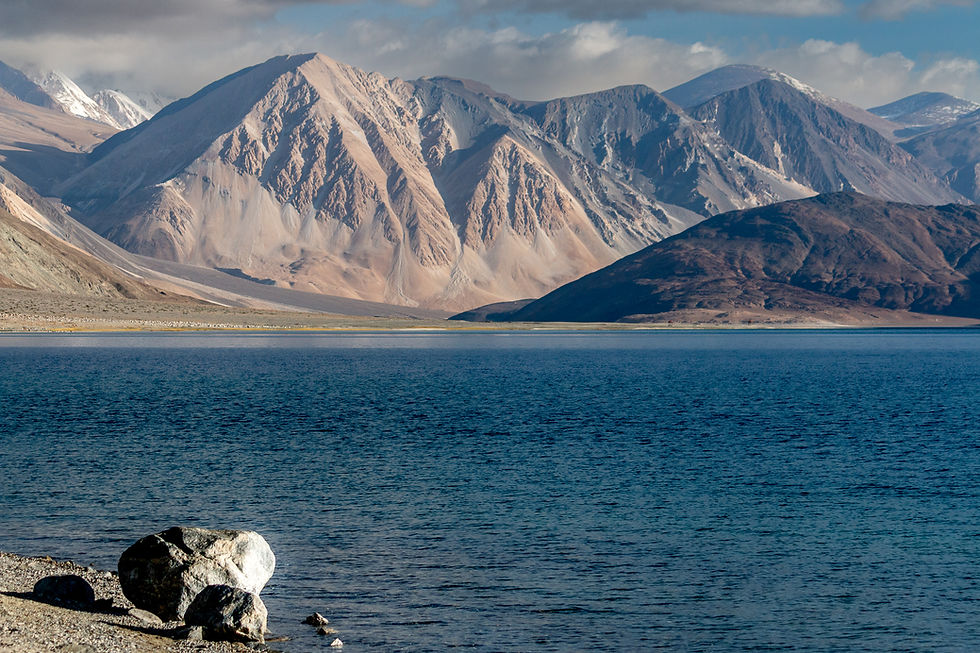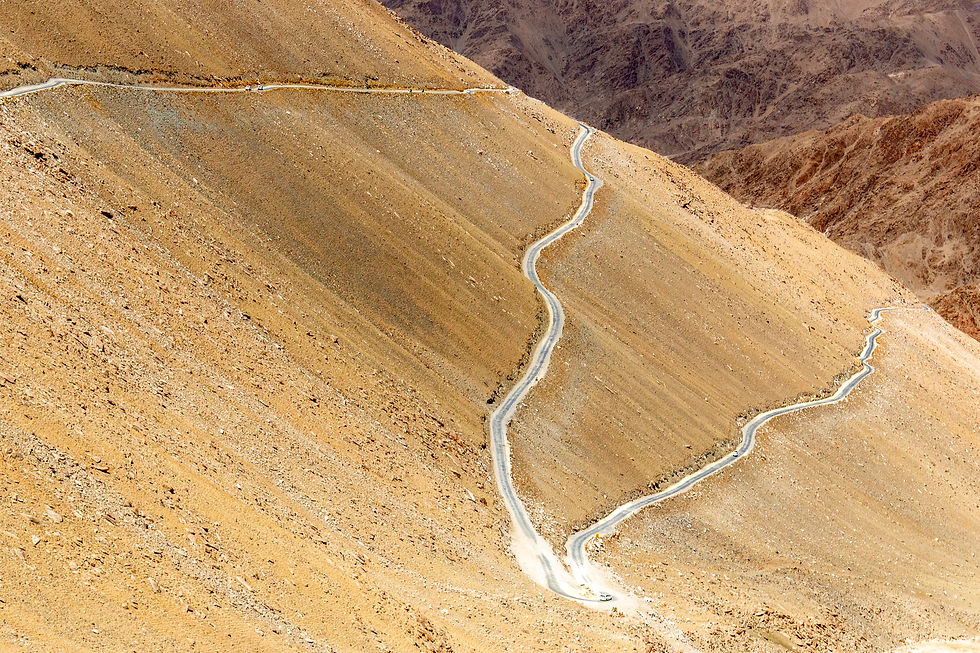The Terrors of Travel and a Trip of Goats: Visiting Pangong Lake in Ladakh
- Rand Blimes

- May 18
- 5 min read
Updated: Jun 16

This is part of a series that describes the road trips we took from Leh. This post covers our visiting Pangong Lake. The other posts in the series are:
Day trip to the south of Leh (Takthok, Chemrey, Hemis, Thiksey, and the Shey Palace)
Overnight trip to Lamayuru (Indus River, Bagso, Likir, Alchi, and Lamayuru)
You can also find a post with a little bit of background on the Ladakh region here.
The prices to hire car and driver for these trips and many others are set by the Leh Taxi Union. You can find current prices at their website.

Visiting Pangong Lake
You want to learn how to meditate? Really meditate? To control your breathing? Learn to accept what is without desire for change? Just let go and be here now?
Just go to Pangong Lake.
There aren’t significant monasteries there. No crimson-robed monks leading you in guided meditations. I don’t even think I saw a single singing bowl.
Nope. That’s not how you learn to meditate when visiting Pangong Lake.

It’s the drive.
The cliff-hugging, void-staring, hairpin-turning drive will lead you to focus on your breathing, chant a comforting mantra (“everything always works out” is mine), and simply learn to accept whatever fate has in store for you.
You may even receive an honorary doctorate in “fervent prayer” by the time you glimpse the lake’s shore.
You have to. To cope, you must chill. So do what you need to.
The Road to Pangong
The road from Leh to Pangong Lake is spectacular. Barren valleys, with the occasional horse grazing on a tuft of who-knows-what. Mountains on a scale that boggles the mind reach skyward. The Chang La Pass, at 17,590 feet (5,391 meters), will leave you gasping for breath while playing in the snow.
And every time your driver careens down a road that seems to be barely clinging to the side of a cliff—car tires knocking pebbles from the road's edge to tumble endlessly towards the valley below—you remind yourself that these drivers know what they’re doing. They know exactly how fast they can take each turn. They can sense ice on the road like a Jedi. And, of course, they maintain the steering and brakes on their cars with the focus of the world's greatest surgeon playing Jenga for the life of a kitten.

And then, while climbing the pass, in the midst of snow, and wind, and serpentine curves, I looked out my window, over the edge of the road, and down to the valley floor. I wish I hadn't. Because there, lying in the snow, I saw a silent graveyard of vehicles. Some upside down. Some rusted. Some looking distressingly fresh.
Each bearing witness to the fact that sometimes, cars go over the edge.
Gulp.
Breathe in. Breathe out. Everything-always-works-out-everything-always-works-out- everything-always-works-out . . .

Pangong Lake: The Lake That Doesn’t Know About Borders
Pangong Tso (the word tso means “lake” in Ladakhi) is a high-altitude saltwater lake that sits at a staggering 4,350 meters (14,270 feet) above sea level. It stretches over 130 kilometers from India deep into Tibet—China holds about two-thirds of it—making it not just beautiful but geopolitically awkward.
Geologically, it’s fascinating. Despite being a saltwater lake, it freezes solid in winter, which isn’t something most saltwater lakes can brag about. It lies in a basin formed by the tectonic collision of the Indian and Eurasian plates—an ongoing clash that gave us the Himalayas, the Karakoram, and the truly terrifying drive to get here.
But it’s the colors that bring the travelers.
The lake changes shades by the hour—turquoise, ultramarine, silvery gray—depending on the light, the clouds, and some sort of Himalayan magic no one fully understands. It’s cinematic. Literally. Bollywood made it famous with the final scene of 3 Idiots, and now Pangong is on the bucket list of half the subcontinent (and a fair few of us from elsewhere).

Cold Beauty and Wooden Beds
Once again, we benefitted from traveling in Ladakh early in the season: there were only a handful of other travelers at the lake, most of them Indian tourists.
On the other hand, we suffered from traveling in Ladakh early in the season: it got cold at night. Like, really cold.
The ride from Leh to the lake took just over six hours. We arrived tired, and my wife was still recovering from some sort of illness that had hit her in Leh. So we didn’t do much. I grabbed my camera and walked along the lake. I gazed toward the far, far shore, wondering where India stopped and Tibet began. I sat, facing into the cold wind coming off the lake, and just took in the scene.
We’d booked our accommodations when we booked our driver. There were some expensive yurt-type options on the lakeshore, but we ended up with something more, well, “basic.” We stayed in a room attached to a dining hall—just big enough for five wooden slabs topped with a pile of blankets. It was exactly as comfortable as it sounds . . . assuming you think that sounds really, really uncomfortable.
Try this: throw a blanket over your kitchen table, hop on, add several more blankets, turn the heat way, way down, and try to sleep. Let me know how you do.
The food was simple. It was edible. But not good. We managed. It's kind of what you expect over 4000 meters.

Baby Goat Redemption
The next morning, Pangong Lake gave us a cute little surprise. Or more accurately, a pen full of cute little surprises.
As I walked back from the lake to our room, I heard a sound. Or maybe a cacophony. It sounded like a kindergarten class of kazoo players who’d just discovered sugar—and rebellion.
So, I checked it out.

There was a small pen with low walls, and in that pen: a couple dozen baby goats. Friendly baby goats. Happy baby goats. Noisy baby goats.
I immediately went to get my daughters. If you don’t have kids, you probably don’t understand how many hero points you get as a parent who introduces their kids to a gaggle of friendly baby goats. It instantly elevates you to boss level.
We had a lovely morning playing with the little goats before it was time to hop back into the car and ply the death-roads to our next destination (Turtuk).

And here is an interesting note: technically, “herd” is the most common word for a group of goats (probably thanks to Julie Andrews). But the word “trip” is also acceptable.
So we saw a trip of goats.
Because travel words are just like travelers: they are everywhere.



Comments